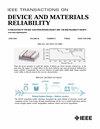Memristive Switching Behavior of MoO3 Decorated PSi Heterostructure and Impact of Temperature on Device Reliability
IF 2.3
3区 工程技术
Q2 ENGINEERING, ELECTRICAL & ELECTRONIC
IEEE Transactions on Device and Materials Reliability
Pub Date : 2025-04-24
DOI:10.1109/TDMR.2025.3563885
引用次数: 0
Abstract
This paper presents the fabrication, testing device reliability and impact of temperature variation on the MoO3 decorated PSi heterostructure. The memristor devices are fabricated using standard microfabrication processes. The MoO3 decorated PSi heterostructure memristor has shown the current switching ratio, resistance switching ratio of 67 andMoO3修饰PSi异质结构的忆阻开关行为及温度对器件可靠性的影响
本文介绍了MoO3修饰PSi异质结构的制备、测试装置的可靠性以及温度变化对其影响。忆阻器器件是用标准的微加工工艺制造的。在室温(RT)下,MoO3修饰的PSi异质结构忆阻器的电流开关比为67,电阻开关比为7\ × 10{^{{3}}}$。在RT ~ 100℃的热刺激下,对MoO3装饰PSi异质结构忆阻器器件的可靠性进行了测试。该装置在90°C下的电流开关比为200,比室温下的测量结果高出近三倍。此外,在90°C下使用调制频率测试验证了该装置的稳定性/可重复性。
本文章由计算机程序翻译,如有差异,请以英文原文为准。
求助全文
约1分钟内获得全文
求助全文
来源期刊

IEEE Transactions on Device and Materials Reliability
工程技术-工程:电子与电气
CiteScore
4.80
自引率
5.00%
发文量
71
审稿时长
6-12 weeks
期刊介绍:
The scope of the publication includes, but is not limited to Reliability of: Devices, Materials, Processes, Interfaces, Integrated Microsystems (including MEMS & Sensors), Transistors, Technology (CMOS, BiCMOS, etc.), Integrated Circuits (IC, SSI, MSI, LSI, ULSI, ELSI, etc.), Thin Film Transistor Applications. The measurement and understanding of the reliability of such entities at each phase, from the concept stage through research and development and into manufacturing scale-up, provides the overall database on the reliability of the devices, materials, processes, package and other necessities for the successful introduction of a product to market. This reliability database is the foundation for a quality product, which meets customer expectation. A product so developed has high reliability. High quality will be achieved because product weaknesses will have been found (root cause analysis) and designed out of the final product. This process of ever increasing reliability and quality will result in a superior product. In the end, reliability and quality are not one thing; but in a sense everything, which can be or has to be done to guarantee that the product successfully performs in the field under customer conditions. Our goal is to capture these advances. An additional objective is to focus cross fertilized communication in the state of the art of reliability of electronic materials and devices and provide fundamental understanding of basic phenomena that affect reliability. In addition, the publication is a forum for interdisciplinary studies on reliability. An overall goal is to provide leading edge/state of the art information, which is critically relevant to the creation of reliable products.
 求助内容:
求助内容: 应助结果提醒方式:
应助结果提醒方式:


